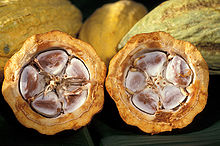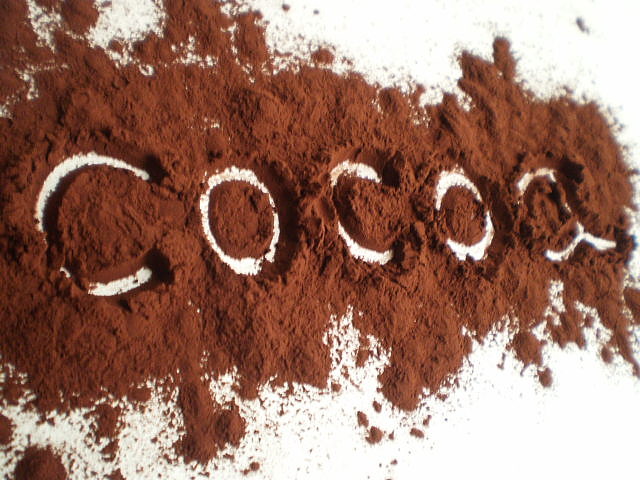चाकलेट बनती है कोकोआ पेड़ के फल से
कोकोआ पेड़ ज्यादा एकुएटर भू मध्य रेखा के आस पास के देशों में पैदा होता है .
जैसा की एकुआडार देश है
http://thestoryofchocolate.com/
Harvesting and Splitting Cocoa Pods
The harvesting of cocoa pods is very labour-intensive. On West African small-holdings the whole family, together with friends and neighbours help out.
Ripe pods are gathered every few weeks during the peak season. The high pods are cut with large knives attached to poles, taking care not to damage nearby flowers or buds. The pods are collected in large baskets, which workers carry on their heads, and piled up ready for splitting.
The pods are split open by hand and the seeds or beans, which are covered with a sweet white pulp or mucilage, are removed ready to undergo the two-part curing process - fermentation and drying. This prepares the beans for market and is the first stage in the development of the delicious chocolate flavour.
Processing the Cocoa Beans

Fermentation
Processing cocoa beans ready for chocolate making involves six main steps:
Fermentation
During fermentation the cocoa pulp clinging to the beans matures and turns into a liquid, which drains away and the true chocolate flavour starts to develop.
Fermentation
During fermentation the cocoa pulp clinging to the beans matures and turns into a liquid, which drains away and the true chocolate flavour starts to develop.
Fermentation methods vary considerably from country to country, but there are two basic methods - using heaps and "sweating" boxes.
The heap method, traditionally used on farms in West Africa, involves piling wet cocoa beans, surrounded by the pulp, on banana or plantation leaves spread out in a circle on the ground. The heap is covered with more leaves and left for 5-6 days, regularly turned to ensure even fermentation.
In large plantations in the West Indies, Latin America and Malaysia, strong wooden boxes with drainage holes or gaps in the slats in the base are used, allowing air and liquid to pass through. This process takes 6-8 days during which time the beans are mixed twice.
In Nigeria, cocoa is fermented in baskets lined and covered with leaves.
Drying and bagging When fermentation is complete, the wet mass of beans is dried, either traditionally by being spread in the sun on mats or using special drying equipment. The cured beans are packed into sacks for transportation to Singapore, where Cadbury processes the beans. After quality inspection they are shipped to the Cadbury processing factory in Singapore, which produces the basic ingredients from which Cadbury chocolate products are made.
On arrival at the factory, the cocoa beans are sorted and cleaned.
Winnowing
The dried beans are cracked and a stream of air separates the shell from the nib, the small pieces used to make chocolate.
The dried beans are cracked and a stream of air separates the shell from the nib, the small pieces used to make chocolate.
Roasting
The nibs are roasted in special ovens at temperatures between 105-120 degrees Celsius. The actual roasting time depends on whether the end use is for cocoa or chocolate. During roasting, the cocoa nibs darken to a rich, brown colour and acquire their characteristic chocolate flavour and aroma. This flavour however, actually starts to develop during fermentation.
The nibs are roasted in special ovens at temperatures between 105-120 degrees Celsius. The actual roasting time depends on whether the end use is for cocoa or chocolate. During roasting, the cocoa nibs darken to a rich, brown colour and acquire their characteristic chocolate flavour and aroma. This flavour however, actually starts to develop during fermentation.
Grinding
The roasted nibs are ground in stone mills until the friction and heat of the milling reduces them to a thick chocolate-coloured liquid, known as 'mass.' It contains 53-58% cocoa butter and solidifies on cooling. This is the basis of all chocolate and cocoa products.
The roasted nibs are ground in stone mills until the friction and heat of the milling reduces them to a thick chocolate-coloured liquid, known as 'mass.' It contains 53-58% cocoa butter and solidifies on cooling. This is the basis of all chocolate and cocoa products.
Pressing
The cocoa mass is pressed in powerful machines to extract the cocoa butter, vital to making chocolate.
The cocoa mass is pressed in powerful machines to extract the cocoa butter, vital to making chocolate.
The solid blocks of compressed cocoa remaining after extraction (presscake) are pulverised into a fine powder to produce a high-grade cocoa powder for use as a beverage or in cooking.
The cocoa mass, cocoa butter and cocoa powder are then quality inspected and shipped to Cadbury factories in Australia and New Zealand, ready to be made into chocolat









No comments:
Post a Comment